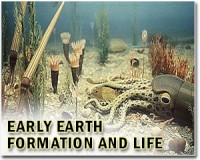| . |  |
. |
Regina, Saskatchewan (UPI) Jan 14, 2011 Scientists say an area of exposed rock in northwest Saskatchewan is a window into the formation of the Earth's crust billions of years ago. The area, dubbed the Athabasca granulite terrane, is exciting geologists who say they would have to somehow transport themselves 25 miles below the planet's surface to see features they can observe underfoot while strolling around hundreds of acres of rocky outcrop, Postmedia News reported this week. The formation was created when a vast amount of molten rock was thrust up from the Earth's lower crust before solidifying at the surface 2 billion years ago. While similar features exist around the world, none are as expansive or varied in the clues they offer into the planet's hidden depths, scientists say. "We do not have the technology to drill anywhere near to the lower crust," Michael Williams, a geoscientist at the University of Massachusetts, says. "But in northern Saskatchewan, we can walk around on lower crust, mapping and sampling. Even if we could drill that deep, we would only get a small round core of rock to look at. In Saskatchewan, we have acres of exposure." Williams says the region still has many secrets to reveal about the creation of the Earth's crust, the formation of mountain chains such as the Himalayas and the dynamics of the San Andreas Fault and other geological rifts. "The region is a natural laboratory for studying the boundary area between the Earth's crust and mantle -- at least the processes that were active in the deep crust long ago," said Williams. "We hypothesize that similar processes are occurring today deep in the crust. This is what makes it so special."
Share This Article With Planet Earth
Related Links Explore The Early Earth at TerraDaily.com
 Ancient oceans said toxic to evolution
Ancient oceans said toxic to evolutionCambridge, Mass. (UPI) Jan 6, 2011 The Earth's ancient oceans became a toxic mix at one point that put the brakes on the evolution of early animals, a paper by U.S. researchers suggests. Scientists at Harvard University say they believe soon after complex animals made their first evolutionary steps forward, a combination of too little oxygen and too much sulfur in the globe's coastal waters led to the extinction of many ... read more |
|
| The content herein, unless otherwise known to be public domain, are Copyright 1995-2010 - SpaceDaily. AFP and UPI Wire Stories are copyright Agence France-Presse and United Press International. ESA Portal Reports are copyright European Space Agency. All NASA sourced material is public domain. Additional copyrights may apply in whole or part to other bona fide parties. Advertising does not imply endorsement,agreement or approval of any opinions, statements or information provided by SpaceDaily on any Web page published or hosted by SpaceDaily. Privacy Statement |